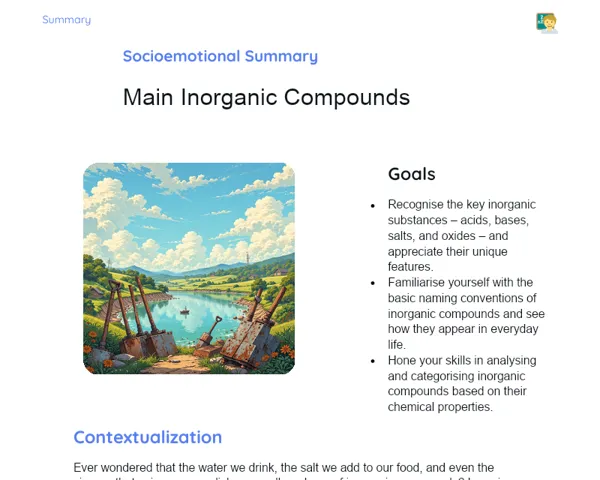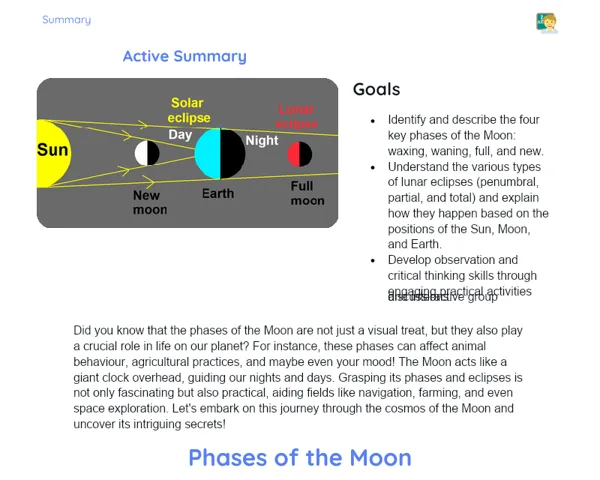Objectives
1. 🌞 Grasp the Earth's movement and its impact on the Sun's position during the day and the creation of shadows.
2. 🔍 Enhance observational and recording skills by tracking how the Sun's position changes and the resulting effects on shadow size.
Contextualization
Did you know that ancient Indian civilizations, much like the Egyptians and Romans, utilized tools akin to sundials for timekeeping? These sundials operated by observing how the Sun cast a shadow from an object onto a level surface, which transformed as the day progressed. This straightforward yet innovative approach highlights how the Sun's movement and the formation of shadows are fundamental concepts that significantly influenced science and technology over the centuries.
Important Topics
Movement of the Earth
Understanding the Earth's movement is vital for comprehending how the Sun's position changes and how shadows are cast. The Earth rotates on its axis, completing one rotation roughly every 24 hours, which creates the cycle of day and night. Moreover, the Earth's elliptical orbit around the Sun leads to seasonal variations and the Sun's changing position throughout the year.
-
Earth's Rotation: The Earth rotates from west to east, explaining why the Sun appears to rise in the east and set in the west.
-
Earth's Orbit: It takes about 365 days for Earth to orbit the Sun, which defines the seasons and alters the Sun's position in the sky throughout the day.
-
Tilt of the Earth's Axis: The tilt of the Earth's axis causes variations in day length and the Sun's elevation in the sky, which affects the seasons.
Shadow Formation
The formation of shadows is closely tied to the relative positions of the Sun and objects on Earth. When sunlight reaches the surface, objects that are not transparent block the light, leading to shadow creation. The Sun's position in relation to an object defines the size, direction, and intensity of the shadow.
-
Direction of Sunlight: Sunlight strikes perpendicular to the Earth's surface, influencing how shadows are formed.
-
Shadow Size: The angle of sunlight hitting an object, along with the Sun's height in the sky, affects the shadow's length.
-
Variation Throughout the Day: The size and direction of shadows shift throughout the day based on the apparent movement of the Sun.
Sundials
Sundials are fascinating tools that use the Sun's position and shadow formation to tell time. They rely on geometry and an understanding of the Sun's path, where an object called a gnomon casts a shadow onto a marked surface to indicate the time based on the shadow's location.
-
Functioning: The gnomon is aligned with true north, and its shadow falls on a flat dial, indicating the time based on its position.
-
Types of Sundials: Different types exist, including horizontal, vertical, and equatorial sundials, each designed for specific latitudes and purposes.
-
History and Importance: Throughout history, sundials were crucial timekeeping devices before the advent of mechanical clocks, used by various cultures.
Key Terms
-
Earth's Rotation: The spinning motion of the Earth around its own axis.
-
Earth's Orbit: The path the Earth follows around the Sun in an elliptical shape.
-
Tilt of the Earth's Axis: The angle between the Earth's axis of rotation and a line perpendicular to its orbital plane.
For Reflection
-
How does the tilt of the Earth's axis alter the seasons and the Sun's position in the sky?
-
Why is understanding the Sun's movement important for fields like agriculture and urban development?
-
How does studying the Sun's position and shadows affect other domains such as history and technology?
Important Conclusions
-
In this lesson, we delved into how the Earth's movement influences the Sun's position and the formation of shadows throughout the day. We learned that the Earth's rotation and its orbit around the Sun are essential for grasping phenomena like day and night, as well as seasonal changes.
-
We highlighted the practical and historical significance of shadows, from their use in ancient sundials to their importance in navigation and day-to-day life.
-
Grasping these concepts isn't just scientifically enriching; it has practical implications in various fields such as architecture, agriculture, and meteorology.
To Exercise Knowledge
- Shadow Observation: Pick an object at home to track and note changes in its shadow throughout the day. Record the time and describe how the shadow evolves. 2. Sundial Sketch: Create a drawing of what an ideal sundial would look like based on your location. Include essential components like the gnomon and the sundial face. 3. Modeling Experiment: Use a flashlight and a small object as the gnomon to simulate the Sun's movement at different times during the day. Observe how the shadow changes as you move the flashlight.
Challenge
🌟 Shadow Scientist Challenge: Start a shadow diary for one week. Pick an object in your garden or on the street and draw its shadow daily at the same time. At the end of the week, write a paragraph reflecting on what you learned about the Sun's movement through the observed changes in your chosen object's shadows.
Study Tips
-
📚 Utilize visual aids: Explore online videos and animations that illustrate the Sun's motion and shadow formation for a clearer understanding of the concepts discussed.
-
📏 Measure lengths: Measure the lengths of various shadows at fixed times of day to observe the theory in action. This will reinforce your understanding.
-
👥 Engage in discussions: Share your insights on the Sun's positions and shadows with friends or family. Teaching someone else is a powerful way to solidify your knowledge!



